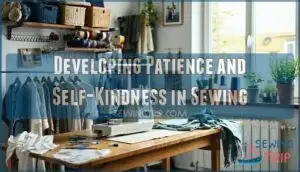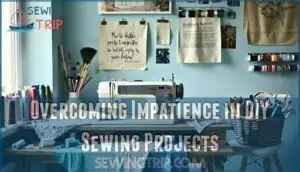This site is supported by our readers. We may earn a commission, at no cost to you, if you purchase through links.

Every stitch matters, and mistakes often mean starting over or spending time carefully removing threads. Learning new skills takes practice, and even experienced sewers encounter unexpected challenges.
Your first buttonhole won’t be perfect, and that’s okay. The beauty lies in accepting the learning process and finding peace in the rhythm of your machine.
Patience isn’t just helpful in sewing—it’s essential for creating anything you’ll be proud to wear or display. The real magic happens when you discover how this measured approach transforms both your projects and your mindset.
Table Of Contents
- Key Takeaways
- Sewing as a Practice of Patience
- Developing Patience and Self-Kindness in Sewing
- The Learning Curve of Sewing
- Overcoming Impatience in DIY Sewing Projects
- The Importance of Taking Your Time in Sewing
- Patience and Precision in Sewing Techniques
- Dealing With Frustration in Sewing
- Patience in Sewing for a Perfect Fit
- The Role of Patience in Sewing Complex Projects
- Enjoying The Journey of Sewing
- Frequently Asked Questions (FAQs)
- Conclusion
Key Takeaways
- You’ll develop patience naturally – Sewing’s slow pace and precise techniques force you to work deliberately, teaching you to embrace mistakes as learning opportunities rather than rushing through projects.
- Mindful stitching reduces stress – The repetitive motions and focused attention required create a meditative state that calms your mind and provides relief from daily pressures.
- Mistakes become valuable teachers – Each error teaches you something new about fabric behavior, machine settings, or techniques, transforming frustration into growth opportunities.
- Quality improves when you slow down – Taking time for careful measurements, precise cutting, and deliberate stitching prevents costly mistakes and creates professional-looking results you’ll be proud to wear.
Sewing as a Practice of Patience
Sewing’s rhythm naturally teaches patience through repetition and focus.
Each stitch builds the quiet strength that transforms both fabric and soul.
When you pick up needle and thread, you’re entering a world where rushing leads to tangled messes and crooked seams.
Each stitch demands your full attention, creating a meditative state that calms your mind.
Mindful stitching transforms everyday fabric into something meaningful.
You’ll discover that slow sewing isn’t just about technique—it’s about finding peace in the process.
Your fingers learn to move deliberately, creating patient progress with each careful motion.
This calm creation becomes your refuge from life’s chaos.
Serene crafting develops naturally as you embrace sewing’s unhurried pace, turning potential sewing frustration into genuine satisfaction through mindfulness and acceptance.
Developing Patience and Self-Kindness in Sewing
You’ll discover that sewing naturally teaches you to be gentler with yourself as you work through mistakes and challenges.
The craft becomes a powerful teacher of self-compassion when you learn to treat errors as stepping stones rather than roadblocks.
Reflecting on Developing Patience and Self-Kindness
When you take time to reflect on your sewing journey, you’ll discover that patience and self-kindness aren’t just helpful—they’re essential.
This self-compassion practice transforms sewing frustration into sewing relaxation.
- Accept that crooked seams teach you more than perfect ones
- Celebrate small victories like threading your needle on the first try
- Remember that even master sewers once struggled with basic stitches
- Turn mistakes into opportunities for mindful stitching
- Practice serene sewing by breathing through challenging moments
Embracing imperfection with a growth mindset makes every project meaningful, not just the finished product.
Cultivating Mindfulness in Sewing Practice
When you focus on the present moment during sewing, you’ll discover how mindful stitching transforms your practice.
Pay attention to sensory awareness—the fabric’s texture, thread’s weight, needle’s rhythm.
This thought taming creates inner serenity that enhances your sewing patience.
Mindfulness naturally develops creative flow, making each stitch intentional rather than rushed.
Sewing relaxation emerges when you embrace patience over perfection.
Embracing Errors and Avoiding Perfectionism
Every sewing project brings unexpected twists that test your patience and help you grow.
These moments aren’t failures—they’re opportunities to develop a growth mindset and embrace the beauty of imperfection.
- Mistakes are learning opportunities that strengthen your skills
- Imperfect is okay—handmade charm beats machine precision
- Release expectations and enjoy the process of discovery
Perfectionism kills creativity, but sewing patience transforms mishaps into masterpieces.
Practice mindfulness when errors arise, knowing each mistake builds resilience and teaches valuable lessons about your craft.
The Learning Curve of Sewing
Learning to sew means climbing a steep hill at first. Your fingers fumble with thread, and seams refuse to cooperate. But here’s the thing—every expert started exactly where you’re now.
Skill acquisition follows predictable patterns. Initial error rates hit 30% for beginners, which sounds scary but isn’t unusual. Manual depth averages 40 pages for basic machines, showing how much there’s to learn. Focus demands increase with project complexity, but your attention span grows stronger too.
Fabric selection is key, with cotton being beginner-friendly due to its ease of use. The learning curve isn’t your enemy—it’s your teacher. Each mistake reveals something new about fabric behavior or machine settings.
| Learning Phase | Common Experience |
|---|---|
| First Month | Tangled threads, wonky stitches |
| Month 2-3 | Straight seams, basic hems |
| Month 4-6 | Simple garments, confidence builds |
Frustration transforms into breakthrough moments when techniques finally click. Your patience deepens naturally as skill development progresses, creating a beautiful cycle of growth and understanding. This process helps you understand that the learning curve is a natural part of skill development, and it’s essential to be patient and persistent.
Overcoming Impatience in DIY Sewing Projects
DIY sewing projects can test your patience, but impatience doesn’t have to derail your progress. When frustration builds, remember that every sewist faces the same struggles you’re experiencing right now.
Every sewist faces the same struggles – you’re not alone in this creative journey.
Here are five strategies for managing impatience:
- Practice mindful stitching – Focus on each stitch rather than rushing to finish
- View challenges as Quick Wins – Each problem solved builds your skills
- Set Realistic Expectations through proper Project Planning
- Take breaks for Stress Reduction when frustration peaks
- Celebrate small successes to maintain momentum
Smart Time Management means accepting that sewing takes time. A useful tool is a sewing project planner to keep things organized. Each mistake teaches you something valuable about your craft. With patience and mindfulness, you’ll develop the skills needed for beautiful, lasting creations.
The Importance of Taking Your Time in Sewing
When impatience strikes during sewing projects, remember that rushing leads to more problems than solutions. Quality vs. Speed matters here – taking your time prevents costly mistakes that require hours of seam ripping.
You’ll find greater Project Enjoyment when you’re not constantly fixing errors caused by hurrying. Mindful Creation transforms sewing from a race into a relaxing experience.
Set realistic expectations and break complex projects into smaller steps. This approach reduces frustration and improves your time management skills. Each careful stitch contributes to Skill Refinement, building muscle memory that eventually makes you faster naturally.
Effective sewing also involves mastering good time management techniques to complete projects efficiently. Patience in sewing isn’t about moving slowly – it’s about moving deliberately.
When you honor the process, you’ll notice improved accuracy and discover that mindfulness actually saves time in the long run. This approach leads to a more enjoyable and efficient sewing experience, where time management and Skill Refinement go hand in hand.
Patience and Precision in Sewing Techniques
You’ve spent time perfecting your basic skills, but now it’s time to focus on the techniques that separate good sewers from great ones. Sewing Accuracy and Precision Crafting aren’t just buzzwords—they’re your ticket to professional-looking results.
Patience transforms ordinary stitching into masterful work. When you slow down and pay Attention to Detail, you’ll notice how Thread Control affects your Stitch Quality.
Here’s what makes the difference:
- Measurement Precision prevents costly fabric waste and guarantees perfect fit
- Consistent seam allowances create clean, professional finishes
- Proper Fabric Choice matching requires careful consideration of drape and stretch
Precision in Sewing Techniques isn’t about perfection—it’s about mindful execution. Each stitch becomes deliberate rather than rushed. You’ll find that taking extra time for accurate cutting and careful pinning pays dividends in your finished garment’s appearance and durability.
Mastering sewing machine techniques is essential for achieving professional results.
Dealing With Frustration in Sewing
When your machine jams or seams go crooked, frustration hits like a storm. But here’s the thing – 68% of beginners struggle with thread breakage and machine problems. You’re not alone in this battle.
Take sewing breaks when anger builds up. Studies show breaks reduce errors by 22%. Step away, breathe deeply, then return with fresh eyes. This isn’t giving up – it’s smart frustration management.
Try mindful stitching techniques. Focus on each stitch like meditation. When mistakes happen, practice error analysis instead of harsh self-criticism. Ask yourself: "What can I learn here?" This calm approach transforms sewing frustration into growth opportunities.
Remember, perseverance beats perfection every time. Even experienced sewists make mistakes daily.
Patience in Sewing for a Perfect Fit
Three out of four sewers struggle with fit issues because they rush through the measuring and adjusting process.
Your sewing mindset matters more than you think.
When you’re hunting for that perfect fit, patience becomes your best friend.
Professional tailors average three fittings per garment for good reason.
Each adjustment teaches you something new about fabric selection and how different materials behave on your body.
Those fitting techniques you’re learning?
They’re building blocks that stack up over time.
Here’s the thing about garment construction – it’s not just about following directions.
You’re developing tailoring tips that’ll serve you for years.
Sewing for beginners often means accepting that seam ripping happens.
Even experienced sewers redo seams regularly.
Your sewing techniques improve when you slow down and really focus on each step.
Those sewing tips about checking fit before final stitching?
They’re gold.
Trust the process, and you’ll nail that perfect fit.
The Role of Patience in Sewing Complex Projects
Advanced sewing projects demand patience like a marathon runner needs endurance.
When tackling intricate designs with complex stitching patterns, rushing becomes your biggest enemy.
Professional tailors report that patience is essential for managing detailed work and avoiding costly errors.
Complex garments involve over fifty individual steps, each requiring careful attention.
Mistakes in these projects can add twenty to thirty percent more time for corrections.
But here’s the silver lining: patient sewers experience thirty-five percent higher project completion rates.
Effective time management means setting realistic expectations.
Break large projects into manageable chunks.
When sewing challenges arise, pause and reassess rather than pushing through frustration.
Your fabric selection and sewing techniques deserve deliberate consideration.
Remember, sewing mastery develops through consistent practice.
Each complex project builds your sewing skills, transforming challenges into opportunities for growth and precision crafting.
Enjoying The Journey of Sewing
Wonder transforms ordinary fabric into extraordinary creations when you embrace your sewing journey with the right mindset.
Rather than rushing toward finished projects, you’ll discover that patience opens doors to deeper enjoyment and personal growth. Your sewing experience becomes richer when you focus on each stitch, each decision, and each moment of creative expression.
The journey itself offers countless rewards that extend far beyond completed projects:
- Mindful moments during fabric selection help you connect with textures and colors
- Problem-solving skills develop naturally as you work through challenges
- Creative confidence grows with each successful technique you master
- Community connections form when you share your progress with fellow sewers
- Stress relief emerges from the meditative rhythm of stitching
When you shift your sewing mindset from destination-focused to process-oriented, you’ll find that mistakes become teachers rather than frustrations. The sewing community celebrates this approach because it recognizes that true mastery comes from enjoying every step of your creative journey.
Frequently Asked Questions (FAQs)
What life skills can you learn from sewing?
You’ll develop patience through fixing mistakes, problem-solving skills by troubleshooting issues, creativity through design choices, confidence from completing projects, attention to detail, planning abilities, and resilience when facing setbacks.
Is sewing difficult to learn?
Sewing isn’t difficult to learn, but it does require patience and practice.
You’ll make mistakes at first, but that’s how you’ll improve.
Start with simple projects and gradually work your way up.
How do I learn how to sew?
While complex projects intimidate beginners, simple techniques make sewing accessible.
Start with basic hand stitches, then progress to machine basics.
Practice straight seams on scrap fabric before tackling pillowcases or tote bags.
Do you need patience to make a quilt?
Yes, you’ll need plenty of patience for quilting.
It’s a slow, detailed process with multiple steps, precise cutting, and careful stitching.
Mistakes happen, and rushing leads to errors you’ll regret later, which is why patience is crucial.
How can I improve my sewing skills?
Picture Anna, a beginner who struggled with crooked seams until she practiced daily for two weeks.
Start with simple projects like pillowcases, practice basic stitches consistently, and embrace mistakes as learning opportunities—they’re your best teachers.
Should you use a sewing pattern or tutorial?
You’ll definitely want both patterns and tutorials when starting out. Patterns give you the roadmap, while tutorials show you the actual techniques you’ll need to bring those patterns to life.
Is sewing good for mental health?
Sewing offers powerful mental health benefits through mindfulness and stress relief.
You’ll develop patience, focus, and problem-solving skills while creating something meaningful.
The repetitive motions calm your mind, reducing anxiety and boosting confidence through accomplishment.
Is sewing hard for beginners?
Like learning to ride a bike, sewing’s initial wobbles give way to smooth sailing.
You’ll wrestle with tangled threads and crooked seams at first, but simple projects build your confidence quickly.
Is sewing a hard skill to learn?
Learning to sew isn’t exceptionally hard, but it does require dedication and practice.
You’ll face a learning curve with basic techniques, but starting with simple projects builds confidence.
Patience helps you master the fundamentals.
Are sewing patterns hard to follow?
Pattern-following isn’t rocket science! You’ll master basic patterns quickly with practice. Start simple, read instructions twice, and don’t rush. Most confusion comes from skipping steps or misreading measurements.
Conclusion
Surprisingly, the craft that teaches you to slow down might be exactly what our fast-paced world needs most.
Does sewing require patience? Absolutely—but that’s precisely its gift.
You’ll discover that each careful stitch builds more than just seams; it develops resilience, mindfulness, and genuine satisfaction.
When you embrace sewing’s deliberate pace, you’re not just creating beautiful garments—you’re cultivating a skill that enriches your entire approach to life’s challenges, providing a sense of satisfaction.













